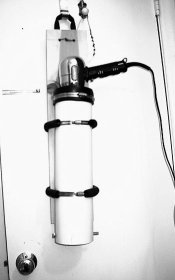OK, since you're not planning to make prints the old fashioned way with an enlarger; there's really no need for a darkroom at all. A changing bag, or preferably a changing tent like Photoflex Film Changing Room because it has more room and is self supporting, will do just fine. I can't think of a good reason not to go this route. All you really need is a dark space to load the your developing tank.
It doesn't really matter which film format you decide to try first. Pick a format and have at it. I should warn you that loading 120 film, because of its thinner support, is a little bit more difficult than loading 35mm film at first. You'll soon get the hang of it in either case and the procedure will become second nature. It's like riding a bicycle. Once you get it, you never forget.
A word about reels and tanks. There is a body of users who swear by stainless steel tanks and reels and another body who swears by the plastic variety. I have a collection of these things that I've gathered over the years and both systems are good. Each has it's own advantages and disadvantages. Stainless steel tank and reel systems' main advantages over the plastic variety are that they use a little bit less chemistry and can offer somewhat easier temperature control because of the steel's naturally higher conductivity. Their main disadvantage is that the reels are a bit more difficult to load and the tanks have a longer fill and drain time. Plastic tank and reel systems, with their automatic loading feature, are easy to load correctly the first time, and have very fast fill and drain times. I use both systems. My plastic tanks hold a maximum of 2 reels with 35mm film or 1 with 120 film, while the steel tanks hold up to 4 reels with 35mm film or two with 120 film. Pay no attention to anyone who tells you you can't get get good results with either system. Both work, and work well once you get used to their individual characteristics. If you like the stainless steel tanks and reels, then DO NOT get cheap reels. They will only frustrate you. The best are made by Hewes. They are expensive, I paid $25 each new in NYC, but will last a lifetime. I do not recommend used SS reels. You don't know if they've been dropped or otherwise damaged. Once they are knocked out of alignment, they will never load properly again.
Chemistry, now there's another religion altogether. Zealots are a dime a dozen in this camp. For starters you have the liquid vs. powdered camp. Then there are the "pyro" maniacs, the "mad scientist" DIY types who like to mix up their stuff from scratch, the "Rodinal is the exlir from the gods" bunch; along with a host of others. Been there, done that, and bought the t-shirt. Overall the best results I've seen come from the following 4 developers: D-76, ID-11, XTOL, and Microphen. Pick one, use it, and learn how to get the best from the film you use with it. D-76 and ID-11 are essentially the same thing, good general purpose developers that will work well with any film you throw at it. XTOL and Microphen, while not as closely related as are D-76 and ID-11, provide similar results and a bit more effective film speed. Personally, I prefer powdered developers. First, they are more economical. The main ingredient in most liquid developers is water. Water is heavy and takes up a lot of space. You need to ship that water and that costs money. Then there is the question of longevity. Any developer that is mixed with water will degrade faster than a dry powdered version. You don't know how long that bottle of liquid concentrate developer has been on the store's shelf. Once you open that bottle of concentrate, its shelf life shortens dramatically.
Acid stop baths are another bone of contention. Some say that an acid stop bath can damage your film. I'm not convinced. I've developed a LOT of film. I have filing cabinets full of negatives dating back to the mid 1960's. Want to know how many have been damaged because I used an acid stop bath? None, zero, nada! Want to know how many are stained because I did not use an acid stop bath and wasn't too careful about washing out ALL the developer before the fix went in? More than I'd care to think about.
Fixing baths are the exception when it comes to the powdered vs. liquid concentrate debate. Ammonium thiosulfate rapid fixers really do work a lot faster than the sodium thoisulfate types and generally don't contain hardeners which you don't need and don't really want. Unfortunately, you can't get these as powder. Typical dilutions are 1+4 for film and 1+9 for paper. At 1+4 the fixing capacity of 1L is well over 10 rolls of film, so it's relatively cheap stuff to use. All brands are pretty much the same with these products, so look for the best price and use that one.
Wash aids are optional for film, and practically indispensable for fiber based papers. They do shorten wash times appreciably and are very good at getting the magenta dyes out of Kodak's TMax films and possibly some others. Finally you should get some sort of wetting agent like Edwal's LFN or Kodak's Photoflo as a drying aid. These products, when used properly, will prevent water marks on your negatives by causing the water to sheet off the film, rather than forming droplets which can leave spots behind.












